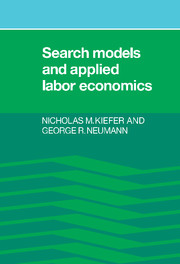Book contents
- Frontmatter
- Contents
- Preface
- 1 Introduction
- Part I Wages, reservation wages, and duration
- Part II Continuous-time models of duration
- Part III Applications
- Part IV Mobility and contracting
- 11 Employment risk and labor market diversification
- 12 A proposition and an example in the theory of job search with hours constraints
- 13 Interfirm mobility and earnings
- 14 Methods for analyzing employment contracts and other agreements
- Index
14 - Methods for analyzing employment contracts and other agreements
Published online by Cambridge University Press: 06 October 2009
- Frontmatter
- Contents
- Preface
- 1 Introduction
- Part I Wages, reservation wages, and duration
- Part II Continuous-time models of duration
- Part III Applications
- Part IV Mobility and contracting
- 11 Employment risk and labor market diversification
- 12 A proposition and an example in the theory of job search with hours constraints
- 13 Interfirm mobility and earnings
- 14 Methods for analyzing employment contracts and other agreements
- Index
Summary
The neoclassical model of demand is the economist's basic tool for studying the relationship among prices, incomes, and quantities consumed. The theory is intuitively pleasing and delivers empirically meaningful restrictions which may form the basis for specification checking. There is an extensive literature on the estimation and interpretation of models of demand in this tradition; important treatments include Deaton and Muellbauer (1980), Phlips (1974) and Theil (1975). The neoclassical model predicts the behavior of the consumer who takes prices as parametric, and who adjusts quantities consumed continuously so that the marginal utilities per dollar spent are equal across commodities. An important class of purchases do not fit well into this framework, namely tied sales and negotiated agreements. An important case in point is the employment agreement.
This chapter considers methods of inferring utility (or demand) function parameters from data on negotiated agreements. These parameters are important for understanding consumer behavior, and practically for predicting responses to policy changes or changes in institutions, whether or not the neoclassical model is appropriate. As we shall see, the specification of the stochastic structure of the model is crucial to the problem of inference when agreements are involved. Additive “errors” cannot simply be tacked on to deterministic demand functions as is typically done when the neoclassical model is applied (but see Theil (1975) for a supporting theory).
- Type
- Chapter
- Information
- Search Models and Applied Labor Economics , pp. 284 - 292Publisher: Cambridge University PressPrint publication year: 1989



